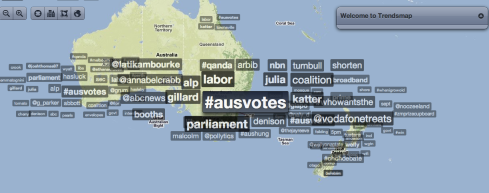By Min
Australia’s political standstill has finally come to an end. Three weeks after the election, Facebookers and Tweeters across the nation herald in our newest ginger addition to the parliamentary family.

I have been debating different ways to approach this broad issue of social media and politics, for quite some time now. Having created and abandoned probably three or four ideas now – with time being upon us, I have finally managed to press one out.
What I found extremely interesting was the difficulty I had pinning down a single idea related to social media/politics, and being able to stick with it before it became irrelevant.
It seems every idea I came up with had a very limited lifespan. There one day, gone the next. Trending now, not so trendy later…
Let’s take a look at Australian twitter trends, pre- and post-election –
The day before election: political hashtags galore –
And then, just weeks later –
Not so long ago, politicial issues were all the rage on these social media sites. And then, as quickly as it began, we saw a dramatic drop in interest and relevancy. So this begs the question – is this the imminently morbid reality of social media and politics? Will it amount to anything more than just a superficial political glaze?
Certainly a yummy, colourful and appetising addition on the political doughnut – but it seems to me that social media just doesn’t have the dough or the nuts that traditional mainstream media offiers – to continue the discussion of national issues as important as politics, long after it is no longer ‘trendy.’
For this reason, I believe the previous panic about the eventual redundancy of traditional media is no longer at issue. Whilst traditional media is often associated with “serious” issues (and I think they have lived up to this image quite well) – new media covers those which are not-so-serious. However, the two have since developed a rather unique relationship:
Think of a traditional media trend as a large, slow moving ball – one which picks up media issues selectively, as it rolls slowly through them. It can hold many at the same time, picking up as it goes along, and slowly dispersing as they become outdated. Such are the dynamics of traditional media – providing continuous coverage of a series of issues, keeping it within its media cycle for some time before moving onto something else.
Social media, on the other hand, can be seen as a sleek fast moving pin-ball, shooting through issues quickly and rapidly, picking up only one or two at a time. When an issue does latch on, its impact is so sudden and viralistic – there is seemingly no rhyme or reason as to why it developed into a trend in the first place (think Numa Numa dance). The social media pin-ball whizzes through the internet community rapidly and easily, representing and making things viral, one trend at a time.
Does this mean social media is more superficial than traditional media? Yes, there is no doubt about it. But is it less meaningful?
Certainly not.
The nature of social media means that it can potentially make viral any issue – serious, non-serious, Numa Numa dance or Barack Obama. Nic Newman’s study of social media and the UK elections indicate channels such as Facebook and Twitter – though “superficial” – have in fact successfully engaged the younger demographics, with record-breaking levels of participation (voting turnout of 18- to 24-year-olds increased by 7%, above the national average of 5%).
To me, this means that when social and traditional media intersect – which they often do – issues such as politics have a far greater (and younger) audience than ever before. I do not think the superficiality of social media coverage is quite as devastating as some believe. If you compare what was before (more incognizance, less awareness) to what is now (more awareness – albeit superficial) – I would argue we are far better off in the latter situation, in terms of overall democracy and citizen well-being.
Clearly, we have much to learn of this intricate relationship, as Newman believes new media is still “yet to come of age.” So far, social media patterns have been almost impossible to predict – forever changing, diverging, appropriating – what will be interesting (and equally challenging) is to be able to successfully pinpoint investigative issues, that will not suddenly become untrendy and lose relevance, as is so characteristic of the volatile unpredictability of social media.



Leave a comment